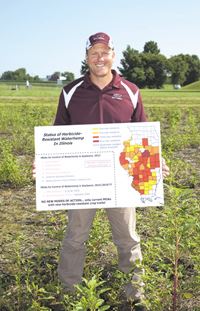Man Vs. Weeds
Often Tillage, Rotation Needed To Overcome Weed Infestation
BETTY VALLE GEGG-NAEGER
MidAmerica Farmer Grower
BELLEVILLE, ILL.
The challenges of weed management in today’s production systems were the
topics of discussion for Dr. Bryan Young, Professor of Weed
Science/Agronomy in the Department of Plant, Soil and Agricultural
Systems at Southern Illinois University. He compared weed management
with the change in production systems and how the methods have evolved
over time.

Dr. Bryan Young, Professor of
Weed Science/Agronomy in the Department of Plant, Soil and Agricultural
Systems at Southern Illinois University, discusses the challenges of
weed management in today’s production systems.
Photo by John LaRose, Jr.
“We’ve used a lot of mechanical tillage and man and human power to
manage our weeds throughout history, and then we’ve gravitated more
towards using tractors and cultivation, and now chemicals and
genetically modified crop traits that we’ve been utilizing such as the
Roundup Ready system,” he explained. “It’s been a continual evolution of
how we manage weeds but it’s been really gravitating mostly to
chemicals. That’s where the challenge comes because we’ve reduced our
dependence on some of the other weed control methods, such as mechanical
and cultural control methods, and we’ve gone more towards chemical weed
control. The advent and use of herbicides has been extremely positive
for modern agriculture, but it has been the departure from other control
methods that has created our primary challenges with weeds today.”
These practices have brought with them an increase in herbicide
resistant weeds. Young emphasized the amount of herbicide resistant weed
infestations occurring today.
“Throughout the vast majority of counties in Illinois are waterhemp
biotypes with resistance to multiple herbicide modes of action,” he
said. “This is of particular interest because if we just had weeds
resistant to Roundup, glyphosate products, that would be one thing; but
waterhemp is also resistant to some of the older herbicides that we use
in an attempt to control weeds that glyphosate won’t kill. Thus, it’s
the multiple herbicide resistance to older herbicides that has
previously existed in our fields and now we added glyphosate to it.
That’s one of our biggest challenges, we’re running out of some
herbicide options.”
“I’ve been having phone calls like they’ve had in the Midsouth for
Palmer amaranth, but in this case it’s for waterhemp,” Young added.
“We’ve used a residual herbicide, we’ve used a glyphosate and another
PPO-inhibiting herbicide post emergence, sometimes twice, and we have
very little control of our waterhemp. What do we do?
“If it’s early enough in the growing season the option is to till the
field and plant soybeans again, he said. That’s been an issue in the
south with cotton and soybean fields that had Palmer amaranth
infestations, but it’s also now an issue in Illinois with waterhemp, at
least in the southern portion of the state.
“We don’t have any more post emergence options in glyphosate-resistant
soybeans to rescue a field, they just aren’t available. So we’re looking
toward the future, looking for future integration of new technologies
to improve weed management; but in the meantime, farmers need to remain
diligent and go ahead and utilize as many effective herbicides as
possible to get multiple modes of action at these weeds, pre-emergence
preferably, so the weeds never come up; then hopefully we will observe
some more consistent control and successful management if we continue
down that line,” he summed.∆
BETTY VALLE GEGG-NAEGER: Senior Staff Writer, MidAmerica Farmer Grower